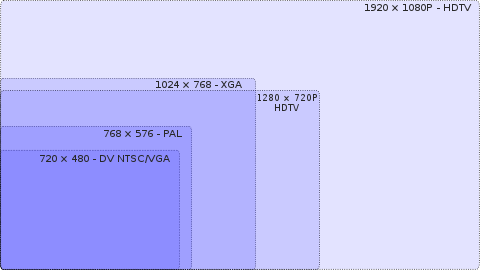HDTV broadcast systems are defined threefold, by:
- The number of lines in the vertical display resolution.
- The scanning system: progressive scanning (p) or interlaced scanning (i). Progressive scanning redraws an image frame (all of its lines) when refreshing each image. Interlaced scanning redraws the image field (every second line) per each image refresh operation, and then redraws the remaining lines during a second refreshing. Interlaced scanning yields greater image resolution if subject is not moving, but loses up to half of the resolution and suffers "combing" artifacts when subject is moving.
- The number of frames per second or fields per second.
The 720p60 format is 1280 × 720 pixels, progressive encoding with 60 frames per second (60 Hz). The 1080i50 format is 1920 × 1080 pixels, interlaced encoding with 50 fields per second. Sometimes interlaced fields are called half-frames, but they are not, because two fields of one frame are temporally shifted. Frame pulldown and segmented frames are special techniques that allow transmitting full frames by means of interlaced video stream.
For commercial naming of the product, either the frame rate or the field rate is dropped, e.g. a "1080i television set" label indicates only the image resolution.[5] Often, the rate is inferred from the context, usually assumed to be either 50 or 60, except for 1080p, which denotes 1080p24, 1080p25, and 1080p30, but also 1080p50 and 1080p60 in the future.
A frame or field rate can also be specified without a resolution. For example 24p means 24 progressive scan frames per second and 50i means 25 interlaced frames per second, consisting of 50 interlaced fields per second. Most HDTV systems support some standard resolutions and frame or field rates. The most common are noted below.
Standard resolutions
When resolution is considered, both the resolution of the transmitted signal and the (native) displayed resolution of a TV set are taken into account. Digital NTSC- and PAL/SECAM-like signals (480i60 and 576i50 respectively) are transmitted at a horizontal resolution of 720 or 704 "pixels". However these transmitted DTV "pixels" are not square, and have to be stretched for correct viewing. PAL TV sets with an aspect ratio of 4:3 use a fixed pixel grid of 768 × 576 or 720 × 540; with an aspect ratio of 16:9 they use 1440 x 768, 1024 × 576 or 960 × 540; NTSC ones use 640 × 480 and 852 × 480 or, seldom, 720 × 540. High Definition usually refers to 720 vertical lines of resolution or more.
Common High-Definition Display Resolutions
| Resolution (WxH) | Pixels | Aspect Ratio | Name | Description |
| 1024×768 | 786,432 | 16:9 (non-square pixels) | 720p/XGA | Used on PDP HDTV displays with non square pixels |
| 1280×720 | 921,600 | 16:9 | 720p/WXGA | Used on Digital television, DLP, LCD and LCOS projection HDTV displays |
| 1366×768 | 1,049,088 | 16:9 | 720p/WXGA | Used on LCD/PDP HDTV displays (HD Ready, HD Ready 720p,1080i) |
| 1024×1080 | 1,105,920 | 16:9 (non-square pixels) | HD1080 | Used on PDP HDTV displays (HD Ready, HD Ready 720p,1080i) |
| 1280×1080 | 1,382,400 | 16:9 (non-square pixels) | HD1080 | Used on PDP HDTV displays (HD Ready 1080p) |
| 1920×1080 | 2,073,600 | 16:9 | 1080p HDTV standard format | Used on all types of HDTV technologies (HD Ready 1080p, Full HD) |
A common resolutions used in HD Ready LCD TV panel are 1366 x 768[6] pixel instead of 1280 x 720 pixel - ATSC Standards. It is due to standard manufacturing yield and maximise resolution on VGA, VRAM that come with 768 pixel. Hence LCD manufacturers set to 16:9 ratio to be compatible for HD Ready 1080p standard, but nevertheless every HDTVs will have an overscan processing chipset to fixed resolution scaling and color screen, eg LG XD Engine, SONY BRAVIA Engine. Only when viewing 1080i/1080p HD contents under HD Ready 1080p where there are true pixel-for-pixel reproduction, and for HD ready LCD TV, there would be some signal undergoing scaling process which result in 3-5% loss of picture.
http://en.wikipedia.org/wiki/High-definition_television

No comments:
Post a Comment